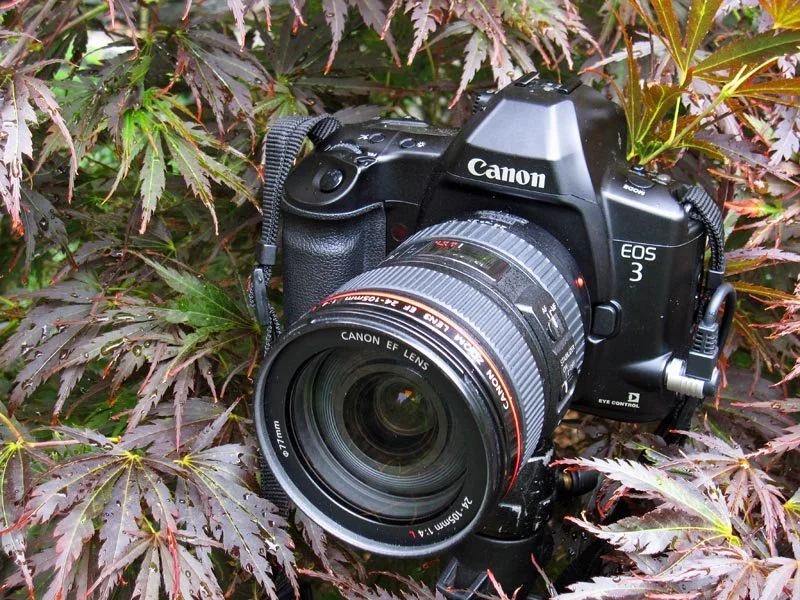Photographic background and hints
I have spent most of my photographic life using the wonderful Fuji Velvia slide film. Unfortunately, I was eventually forced to change to digital photography, mostly because of the final death of my trusty Minolta film scanner and because my printers could no longer deal with film. Digital scores over the film in sharpness of the results (especially once the film has had to be scanned digitally), but in my opinion does not get near it in quality of light and of colour. In order to get the final results looking as good as they would have looked on slide film I have to spend time editing the photographs - this goes against the grain with me and I do it through gritted teeth!
As I moved from film to digital, I retired my trusty Canon EOS3, used a Canon 6D for a number of years, and am currently using a Canon5D MkIV. Usually carrying 2 zoom lenses with a Canon 24-105mm and a Canon 70-300mm. Although I have splashed out on a carbon fibre tripod, I keep returning to my trusty 30+ year old Uniloc metal monster. There are 2 types of filter that I use regularly - a polariser and graduated NDs.
I have not trained or studied photography, and prefer to approach things by 'feel' rather than by calculation. I do not have a great depth of technical knowledge, but do have many years of experience using a camera in testing mountain conditions. So, with years of trial and error behind me, perhaps I can give a few simple hints that someone might find helpful .....
- Do not try and copy others' ideas - really look at what is around you and see what you can see.
- Do not be constrained by what is considered the 'normal' or 'best' angle of a subject - have a long look as to what is really the best.
- Be willing to walk - the best pictures are not usually taken from the roadside! In order to get these sunrise photographs of Portmeirion and Yr Wyddfa / Snowdon I first had to have the germ of an idea, then study a map to check its viability, so as to ‘envisage’ the possible shot. The approach on the day involved a walk about 1km a marshy shoreline, and a short scramble up a hillside. When I am in a location like this I first of all make sure I get an obvious ‘banker’ image or two. Then I experiment with different foregrounds and different compositions. These two images show how the use of different lenses can result in a very different feel to the images. The first was taken with a telephoto zoom at around 200mm, and it makes Yr Wyddfa / Snowdon look much closer behind Portmeirion than we expect (it’s about 10 miles as the crow flies). The second dawn image was taken on a wide angle zoom at about 24mm and makes everything look further away than the eye sees.
- Be willing for a bit of pain. I find that sunrise and the couple of hours afterwards often produce the best light and strongest colours. Sometimes I start at 2 a.m. so as to be on a mountaintop for sunrise.
- At sunrise or sunset the best light sometimes only lasts a couple of minutes. I will usually try and get a couple of 'bankers' at first, but then use any remaining time trying to work the scene before me in a more imaginative way.
- When shooting at wild locations around the times of sunrise or sunset, try to turn up and set up early. This allows you time to work out what you think your best shot is before the possible 2 minute rush during the very best light. It also allows any lens or filters to get used to the ambient conditions and reduces the chance of them steaming up just when you need them to be crystal clear.
- Remember that the strongest colours in the sky can be 20-30 minutes before sunrise or after sunset. Don't assume that the only worthwhile pictures are to be had at the time of the sun rising or setting.
- Keep in mind that many of the best sunrise or sunset photographs are not necessarily taken looking towards the sun. Often the most striking images at these times are looking at a strong subject that is being lit up by the low and warm light..
Sunrise - Looking down the Ogwen Valley
Snowdon from Crib y Ddysgl
The Cantilever at Dawn
- Think out angles and viewpoints. Sometimes I use a map to work out a good new viewpoint. I can also work out from which angle the sun will be shining. The strongest colours are usually achieved by taking a picture at right-angles to the sun.
- Use a tripod for landscapes, even when you don't need it. This helps you really think out the composition and foreground points of interest. A movement of the camera position of no more than a few inches can make the difference between a good picture and a great picture.
- With digital photography it is possible to 'play' with images in photo editing programs such as Photohop, and significant changes can be made. However, I would strongly advise trying to get the image as near as how you want it to look at the photography stage rather than relying on computer work later. This attitude will produce a higher quality final image, but will also leave you as the photographer feeling more satisfied about how you go about your craft. Computer editing skills are no substitute for real photographic gifting.






